How to Make Light Greek Moussaka
A Greek Dish With International Influences

Greek moussaka (or light Greek moussaka for those who don’t care about the heavy béchamel sauce) is a must-have dish if you travel to Greece, just as it is proper to try Greek coffee or wine. The flavours are unique!
As you sit on a tavern terrace and (preferably) enjoy a fabulous sea view, remember that the stress is on the last syllable when you ask the waiter for moussaka.
Original from the Levant and updated by adding a posh French sauce, moussaka is known as a Greek dish, cooked with variations in most south-eastern Mediterranean and not only. Romanians and Bulgarian also love it.
My recipe of light Greek moussaka is somehow altered, due to health factors. Because time is also an issue for multitasking people, I always chose the least time-consuming method; therefore, the recipe might differ from the original. The taste is still excellent, though!
I like to keep cooking fun but rapid and straightforward. First of all, my moussaka will not contain the famous béchamel sauce. It might sound fancy and add flavour to the dish but, to me, is merely a calorie bomb!
After all, the primary role of the béchamel is to help set the meat layer (it is, in essence, a glue sauce, with origins in medieval Tuscany) and confer superior aesthetics to the finished product.
If you are not concerned about your cholesterol level and want to try it, I will explain later how to make the sauce. I did make the original recipe a few times for others; nobody complained about it, on the contrary!
Now that I have all the Greeks against me, it won’t make any difference to tell you that a bit of Parmesan cheese grated on top during the last minutes of baking will give a lovely flavour to the dish. On occasions, when I did not have hard cheese in the fridge, I just grated some Cheddar and let it melt and bake a little. I did say this dish has international influences!
If for any health reasons, or if you are lactose intolerant and prefer dishes low in fats, remember that the flavour is in the spices, not necessarily in heavy sauces or cheeses.
Speaking about spices, a Greek friend of mine once told me that beef must be the only type of meat in moussaka, and oregano the only other seasoning alongside salt, pepper and nutmeg.
I like a dash of cinnamon and always use thyme in mince meats. But I won’t dare upset the Greeks any farther than this! Though, maybe, just a tiny bit of ground coriander, perhaps?
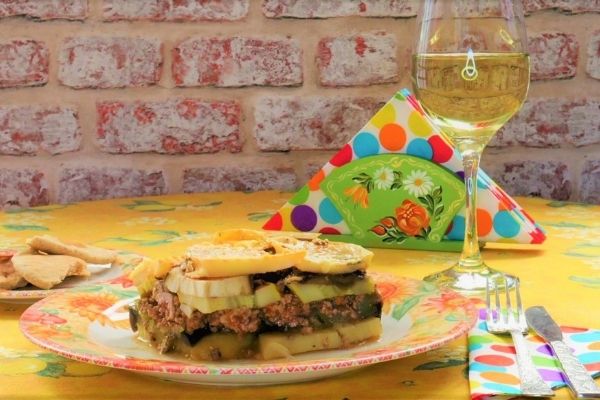
Ingredients for Light Greek Moussaka:
2.5 kg of potatoes (have a few spare ones, in case you remain with an incomplete layer)
800 g (lean) minced beef
Two large onions
One pepper (I prefer the taste of pointed peppers)
Four large tomatoes (or a tin of chopped tomatoes)
Two large aubergines
Three courgettes
Six garlic cloves
Spices: dry oregano, thyme, salt, pepper, freshly grated nutmeg (optional: cinnamon and ground coriander)
Optional – Ingredients for Béchamel Sauce:
1l full-fat milk
100 g butter
100 g plain flour
100 g grated Parmesan or any other hard cheese
Two egg yolks (for colour)
Spices: a tiny pinch of salt (the cheese is salty enough), white ground pepper, freshly grated nutmeg
How to Make Light Greek Moussaka:
Preheat the oven (180°C/350°F).
I always start by preparing the meat. I usually buy two packs of organic lean minced beef. Even the lean meat will have some fats in it, so I do not add any oil. Believe me when I say that your liver will thank you for not caramelizing the onions in oil!
Place the mince in a large pan over medium heat, add a large glass of wine, the finely chopped onions, pepper and tomatoes and stir. Cook it for about ten minutes, stirring occasionally.

When is nearly ready, add the chopped garlic. I always cut garlic with a ceramic knife because stainless steel can oxidise it. Sprinkle the spices, stir for 3-5 minutes, then turn the heat off.
For the veggies, you have three options: fry them in oil (they will absorb it like a sponge!), bake them in the oven for 15-20 minutes, or use them raw.
I prefer the latter option (the other two are either too unhealthy for my taste or time consuming). The result is the same; the heat in the baking phase is enough to cook everything evenly.
Regardless of your chosen method, cut the potatoes, aubergines and courgettes into no thicker than one cm slices.
Perhaps it is a good idea to start with the potatoes and soak them in cold water for a few minutes until you cut the other veggies (to get rid of the excess starch).
In a large baking tray, start with a layer of potatoes (sprinkle a little salt and dried oregano). Continue with a layer of aubergines and courgette (slightly salted).
The next layer is the prepared meat (add half of the béchamel sauce and mix well if you decided to go for it).
Continue with another layer of courgette, aubergines and potatoes, slightly salted. Sprinkle a little dried oregano over the potato slices.

To avoid burning the potatoes, I usually spread a couple of tomato sauce spoonfuls over the last layer before baking. If you made your béchamel sauce, lay the remains of it evenly over the entire surface.
The tray is ready to go in the heated oven for about 50-55 minutes (a little longer for raw veggies – test them with a fork, you’ll know when they are done), at medium temperature (180°C should do).
Just before the time is up, grate some hard cheese on top and bake the moussaka until the cheese starts bubbling.
Let the moussaka cool before you cut it; otherwise, the non-béchamel version can be a bit challenging to place on a plate in one piece (it will not be as glued).
This is a recipe for eight portions because moussaka is a dish that can be stored in the fridge for two to three days or frozen (for a maximum of three months). Of course, fresh is tastier; this is why I make sure to cook it close to mealtime. On the subsequent days, you will have to reheat it before serving.
Light Greek Moussaka goes well served with a Greek salad or a simple salad and pita bread.
Enjoy it with a glass of chilled Retsina, my favourite Greek wine!
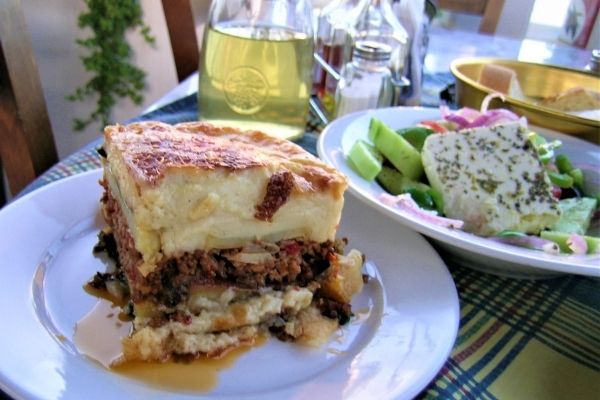
How to Make the Béchamel Sauce:
If light Greek moussaka won’t do for you and you want to try the full-fat version, add béchamel sauce. I promised I would explain how to prepare it, so here it is!
The famous béchamel sauce, originally a salsa colla (Italian for glue sauce), has allegedly been imported by Caterina de Medici, an ambitious Italian noblewoman, to France when she married King Henry II. A couple of centuries later, a marquis in the service of King Louis XIV, called Louis de Béchameil, improved and renamed the sauce after his name and this is how we know it today.
The first step in preparing this sauce is to warm the milk in a pan over medium heat. The milk should not boil, but it has to be quite hot.
In another saucepan, melt the butter without boiling it, over low heat. To add the flour, remove the pan from the heat and pour the flour while whisking vigorously with a stainless-steel whisker. It might look lumpy at first, but continue mixing and the lumps should dissolve.
Return the pan to low heat and gradually add the hot milk, whisking continuously. Add the spices (salt, white pepper, freshly ground nutmeg) and stir continuously for about five minutes or until the sauce starts bubbling.

Remove from the heat to add the egg yolks (one at a time), stirring well. Return to the heat for another minute, stirring continuously. Add the cheese and whisk for another minute or two.
Turn the heat off. The sauce might get a crust as it cools down; you can cover the pan with cling film to avoid this.
The béchamel should have a soft, creamy consistency, similar to the crème fraîche, and a light yellow colour.
Use half of the sauce in the meat filling to help set better when it cools down and spread the other half on top of the moussaka before placing it in the oven. The result will be an added layer that might look prettier if you enjoy aesthetics in foods or want to impress someone!
Bon appetite!
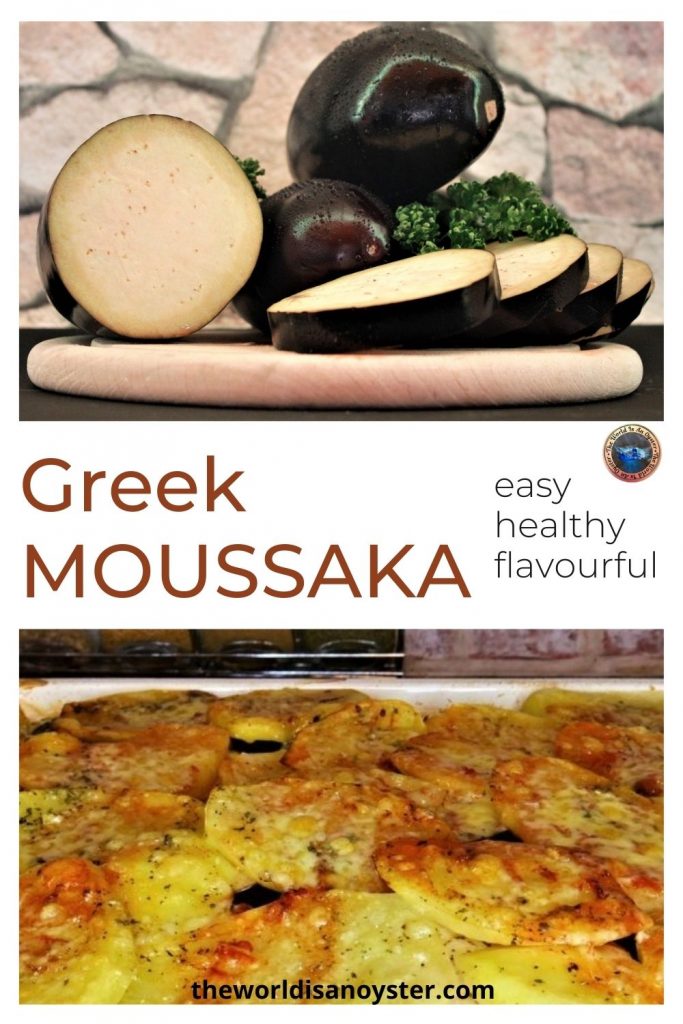
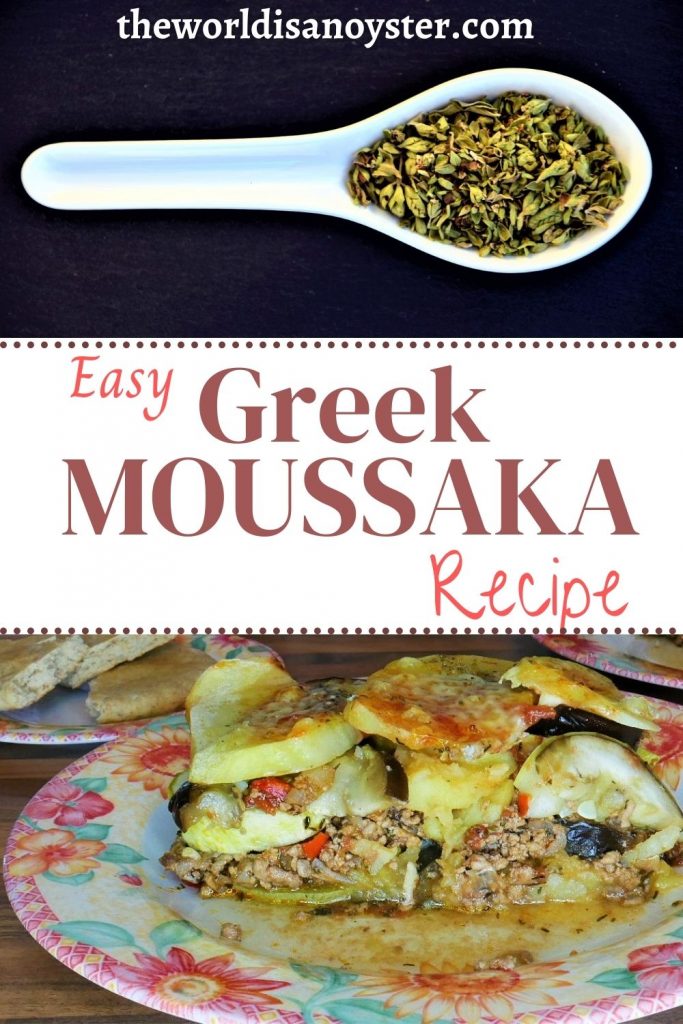

Greek Moussaka
Ingredients
- 2.5 kg potatoes
- 800 g minced beef lean
- 1 pcs pepper sweet pointed
- 4 pcs tomatoes large, or a tin of chopped tomatoes
- 2 pcs onion large
- 2 pcs aubergine large
- 2 pcs courgette
- 6 cloves garlic
- 1 tsp spices (dried oregano, thyme, ground black pepper, freshly ground nutmeg) each
- 1 tbsp rock/sea salt
For the Béchamel Sauce
- 1 l milk full fat
- 100 g butter
- 100 g plain flour
- 100 g Parmesan cheese grated
- 2 pcs egg yolk for colour
- 1 tsp nutmeg freshly ground
- 1 tsp white pepper ground
- ½ tsp rock/sea salt
Instructions
How to Make Greek Moussaka
- Preheat the oven (180°C/350°F/gas mark 4)
- Place the mince in a large pan over medium heat, add a large glass of wine, the finely chopped onions, pepper and tomatoes and stir. Cook it for about ten minutes, stirring occasionally.
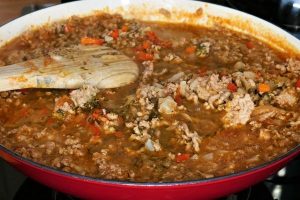
- When it is nearly ready, add the chopped garlic. I always cut garlic with a ceramic knife because stainless steel can oxidise it.
- Add the spices and stir for 3-5 minutes, then turn the heat off.
- For the veggies, you have three options: fry them in oil (they will absorb it like a sponge!), bake them in the oven for 15-20 minutes, or use them raw.
- Regardless of your chosen method, cut the potatoes, aubergines and courgettes in no thicker than one cm slices. Soak the potatoes in cold water for a few minutes (to get rid of the excess starch)
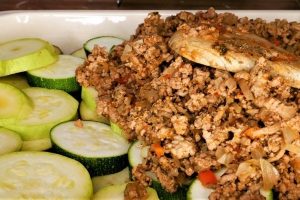
- In a large baking tray, start with a layer of potatoes (sprinkle a little salt and dried oregano). Continue with a layer of aubergines and courgette (slightly salted).
- The next layer is the prepared meat (add half of the béchamel sauce and mix well if you decided to go for it).
- Continue with another layer of courgette, aubergines and potatoes, slightly salted.
- Sprinkle a little dried oregano over this last layer of potatoes.
- To avoid burning the potatoes, I usually spread a couple of tomato sauce spoonfuls over the last layer before baking it. If you made your béchamel sauce, lay the remains of it evenly over the entire surface.

- Bake for 50-55 minutes.
- Just before the time is up, grate some hard cheese on top and bake the moussaka for another 2-3 minutes or until the cheese starts bubbling.

How to Make the Béchamel Sauce
- Warm the milk in a pan over medium heat. The milk should not boil, but it has to be quite hot.
- In another saucepan, melt the butter without boiling it, over low heat.
- Remove the pan from the heat and pour the flour while whisking vigorously with a stainless-steel whisker. It might look lumpy at first, but continue mixing and the lumps should dissolve.
- Return the pan to low heat, and add the hot milk gradually, whisking continuously.
- Add the spices (salt, ground white pepper, grated nutmeg) and stir continuously for about five minutes or until it starts bubbling.
- Remove from the heat to add the egg yolks one at a time, mixing well. Return to the heat for another minute, stirring continuously.
- Add the cheese and whisk for another minute or two, then turn the heat off.
Notes
a bit challenging to place on a plate in one piece (it will not be as glued). Moussaka goes well served with a Greek salad or a simple salad and pitta bread. Enjoy
with a glass of chilled Retsina, my favourite Greek wine! When it is completely cooled, moussaka can be kept in the fridge for up to three days and reheated in the oven before use or frozen for up to 2-3 months. For a vegetarian version, mushrooms are a great substitute for minced beef. Bon appetite!


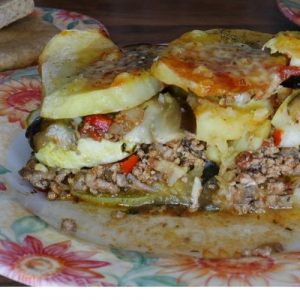

















This looks amazing! I love moussaka and this is such an easy version of the recipe! Thanks for the inspiration and I cant wait to try it!
Mousaka is a delicious main dish, and I hope you will try any of the versions presented. Let me know how it goes!
I had never heard of light Greek moussaka before but it sure looks like a great dish. I like how it looks fairly easy to make and based on the ingredients I’m, sure it is also quite delicious as well. I will have to add this recipe to my list of ones to try.
Moussaka is delicious and quite a hearty meal. I hope you’ll have a go:)
I can’t wait to make it, it sounds really delicious and comforting. I love how you included all these tips like cutting the garlic with a ceramic knife or soaking potatoes to remove excess starch. Learned something new! Thank you!
Glad it helped, enjoy your moussaka!
Such a great dinner idea. I love mussaka.
This Greek moussaka looks fantastic! I will be making it this weekend! So excited!
So good and very easy, thanks!
I love moussaka! Can’t wait to try this!
A fantastic detailed recipe! Thank you!
Love all the layers of vegetables, meat, and bechemel in this recipe. So delicious together.
I had no idea how easy it was to make Moussaka thank you so much for the step by step instructions.
It is, and it’s also very easy to veganize!
I remember making an Americanized version of Moussaka years ago. It did not look as delicious as yours, that’s for certain!
Hehe, Greek food is hard to beat!
You are right, this was so easy! I loved all the flavors and can’t wait to make it again!
Love Moussaka and i would not mind giving your shorter version a spin. It looks amazing. Thank you for sharing
Love Moussaka but never tried to make it a home, now I can! And you make it look so easy 🙂
One of my favorite Greek comfort food dishes!
I don’t think I’ve ever had moussaka before. It looks so delicious! Something to try with out garden bounty this summer. Do you think I could use minced turkey instead of minced beef?
This is a favorite at a local greek restaurant! I am confident with your instructions I can make it at home now.
I’ve never had moussaka before but I can tell from the ingredients it’s going to be delicious! And that sauce is going to take it over the top, great recipe!
I have never heard of greek moussaka but this sounds delicious! Love that you make the steps so easy to follow!
Moussaka sounds delicious! I love the combination of eggplant and zucchini with the potatoes. I’d love to try this without the meat!
You can replace the meat with mushrooms – super yum!
Oh how yummy. I think anything that adds Bechamel sauce is pretty much a guaranteed hit!
I love how full of vegetables this recipe is thank you so much for giving us this great insight on how to make it.
ANd you can skip meat easily; just replace it with tons of mushrooms! I sometimes do, and it is delish:))
This looks delicious. This is one dish I’ve never made but I’ll have to give it a try!
I will definitely try this. I love mousaka…. actually just had some last night. I do enjoy the bechamel, so not sure I would forego that, unless I was pressed for time.
This sounds incredible! I’ve never had moussaka before but it’s definitely a must to make, and of course to try when I travel to Greece one day!
thanks for sharing the origin and a straightforward recipe 🙂
Mousakas in one of my favorite meals! I always order it when we go to a taverna. But with your easy recipe, I will surely try to make it at home as well!
I love moussaka and your recipe looks fantastic. Knowing me, I would likely make the Bechamel sauce. I love the creamy topping that it gives to this dish as well as to the Greek pastitsio. I will certainly give your recipe a try.
I’ve never heard of this dish before but I’m also not Greek, so this doesn’t offend me at all. I’d love to try this recipe out. For most dishes, I find both the “traditional” and the variations of it to be delicious.
This looks super yummy. And I love how you went all non0traditional with the flavors. Great creativity!
I was in Greece and the food was great. I would like to make this recipe, thank you for explaining very well all the steps to do
Mmmmmmmm
Omg, looks do delicious!!! I have heard, that Moussaka is a healthy Greek lasagna… Is that true?
Unfortunately, I don’t have an oven in my kitchen (because it’s too small), but at my mom’s flat, we have one… Your post just really inspired me to make some Greekish lunch for my family! Thank you for that!
Haha, it is similar. I believe both nations are very proud of their specific cuisine so I wouldn’t want to upset anybody. Bottom line is the Mediterranean lifestyle is diverse, healthy, yummy and worth a try, so please get cooking with your mom, it will be fun!
I suddenly remember Lasagna with this recipe, I like that it has a lot of Veggies in it. Looks delicious and interesting to make, except I have to replace the meat and try others as I can’t take them 🙂 Thanks for sharing this!
Mushrooms are the best replacement, it works wonders!
I love Greek food, but have never had moussaka. It sounds delicious and I can’t wait to try, thanks for sharing!
I love Moussaka, but I have never made it myself! Your recipe looks so good! I’m putting it on my dinner plans for the week. 🙂 Thank you for sharing!